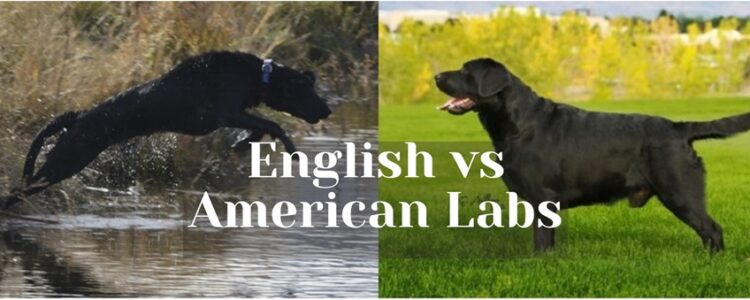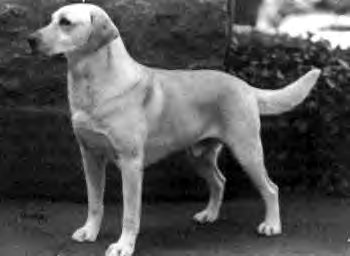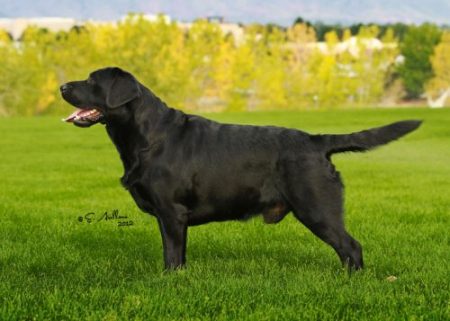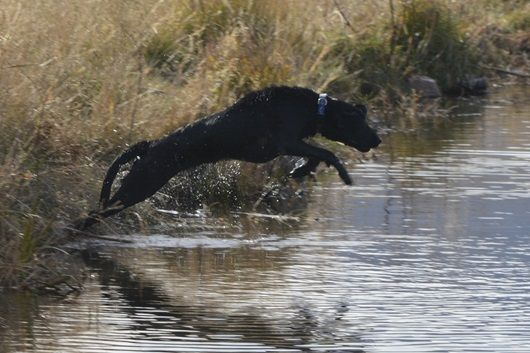
As a long-time Labrador fan, I've owned both the English vs American styles. Some people call them "show" or "field" Labs, as that can be less confusing.
So, what makes one dog an English Lab and another an American Lab? This guide will explain what happened.
Early Labradors in America
From the 1930s when the first Labs were imported through the 1970s, field Labs and show Labs were virtually the same. It was common for show dogs to be bred to field dogs. Even Ebonstar Lean Mac, one of the best-known field trial Labs, descends from show dogs.
Often, individual dogs were a bit better at one sport or the other, but some were good at both. During that time there were 37 Labs that earned both a show championship and a field championship to become Dual Champions.
What Caused The Split
In the 1970s and 1980s, a second wave of British imports began. Some of these dogs were heavier-bodied with blocky heads. Show fanciers in America flocked to them hoping to breed the next big winner.
Meanwhile, field trials were changing. The landscape here is bigger and more open than in England so dogs needed to go farther and faster to win.
Thus started the divergence. Show dogs became shorter and heavier. Field dogs became taller and lighter.
Because show dogs of that time had imported English blood, they were called "English Labs." Originally only the imported dogs were called English, but over time all show-type Labs were called English. Other Labs were called American.
English vs American - Physical Differences
During three decades as the most popular breed in America, striking differences developed between the English vs American styles.
These physical differences aren't just cosmetic, they reflect the different purposes for which the English vs American Labs were bred.
English Labs were bred for show rings, while American Labs were developed for their hunting and field trial abilities.
Energy level
Both English and American Labs are highly trainable, but their different energy levels can affect their training needs.
English Labs:
- Often easier to train for basic obedience
- May be more patient with children and other pets
- Good for therapy work and as emotional support animals
American Labs:
- Great at advanced training and complex tasks
- Thrives on plenty of physical and mental stimulation
- Good for active families and outdoor enthusiasts
Temperament
Both English and American Labs share the Labrador friendliness and eagerness to please. However, there are some slight differences in their temperaments.
English Labs are often calmer and more laid-back. They are great for families and first-time dog owners and they enjoy being a "couch potato."
American Labs often have higher energy levels and are more athletic. They enjoy doing something, whether hunting, competing, or fetching a ball in the yard. They can also be great family dogs.
Different Purposes
The differences in appearance, energy level, and temperament between English vs American Labs are due to their varied purposes.
English Labs are bred for the show ring with a priority on their structure and looks. American Labs are bred for hunting and field trials where they need athleticism, stamina, and working ability.
Most Labs fall somewhere in between with traits from both types.
English vs American Labradors aren't the only choices
Instead, it's a continuum from short and heavy with a large head to tall and slender with a narrow head.
Some show males look more like a Newfoundland or a wrinkled Shar Pei. They are almost a cartoon version of the original Labs that were bred to be field dogs. However, I am seeing a shift to a more moderate dog in the show ring. An exception is at the Labrador-only shows where structure is generally excellent, but more-is-better often reigns.
Some field-bred females have the height, slender legs, and head shape of a Whippet. These dogs can spend all day hunting or retrieving at tremendous distances and still want more. They are often bred for trainability, marking ability, and intelligence rather than their looks.
In between, there are dogs that still look like a classic Labrador. Classic Labs are dogs from early in the breed's history until the breed really started to diverge in the 1960s.
Here are a couple of classic Labs:
First, is Dual CH NFC AFC Can CH Shed of Arden, a great Lab of the past. He not only earned a show championship in two countries, but was also a three-time National Field Champion! Shed was not so tall and lanky as many of the field dogs of today, nor was he so blocky as most of the current show dogs.


Another great from the past was CH Shamrock Acres Light Brigade. "Briggs was an outstanding show dog and sire. He produced 93 AKC Champions and won 12 Best in Show awards and 75 Sporting Group placements." Compared to show dogs today he had longer legs and less substance, but look at those shoulders and the balance! I'd bet he moved exceptionally well.
Additionally, many people just want a Labrador and don't breed for a specific style. The breed's versatility and adaptability allowed it to meet many needs and yet keep it's intelligence, friendliness, and trainability.
Choosing the Right Lab for You
When choosing between an English vs American Lab, consider your lifestyle and what you're looking for in a dog.
- Activity Level: Do you want a more laid-back dog or an energetic exercise partner?
- Living Space: Do you have a large yard or live in an apartment?
- Time Commitment: How much time can you spend training and exercising?
- Family Situation: Do you have young children or other pets?
Remember, these are general guidelines and some dogs might be different. Always meet the dog and, if possible, its parents before deciding.
You can also check out the AKC Breed Standard to read about the "perfect" Labrador.
The differences between these types of Labs allow dog lovers to find a Lab that fits their lifestyle. Whichever you choose, you'll have a great companion with the qualities that make Labradors one of the most popular breeds worldwide.




